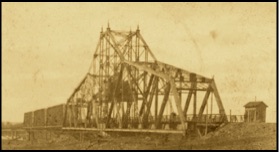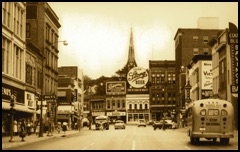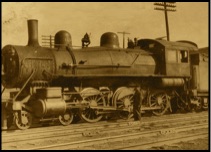Historical Society of
Pottawattamie County
County Seat Council Bluffs, Iowa



History of Council Bluffs' Rock Island Depot...
By Ryan Roenfeld
The Chicago, Rock Island, and Pacific Railroad was built into Council Bluffs in May 1869 and its first depot located near West Broadway and Pearl Street. In July 1873 Frank and Jesse James and the Younger Brothers robbed the Rock Island line near Adair, Iowa. A few years later in 1877 the Rock Island introduced the first dining car in on its express between Chicago and Council Bluffs.
In 1881 while memorial services were being held for President Garfield in Bayliss Park a rail car loaded with dynamite exploded at the Rock Island Depot. According to one source, the explosion shattered "windows a half mile away" and left behind a 12 foot deep crater although somewhat surprisingly no one was killed in the blast.
The Rock Island then used a small frame building on South Main Street heated by "soft coal stoves, and lighted by coal oil lamps" as their passenger depot. However, by late 1880's some local citizens were aghast that the railroads had allowed such important and prominent entrances into their city become so run-down. Seeking to change this, a delegation of Council Bluffs citizen's petitioned the Iowa Board of Railroad Commissioners in 1891.
According to the report released by the board, the Rock Island's frame passenger depot in Council Bluffs consisted of a "baggage room, a waiting room for men 21 by 23 feet, and a waiting-room for women, of about the same size, with a ticket office taken out of the two rooms 13 by 10 feet." Lacking toilet facilities "in no manner suitable for the purpose for which it is intended. No wash basin and no conveniences," the railroad commissioners found that the depot "does not afford reasonable accommodations and convenience for the public doing business with said company..." The Rock Island was given sixty days to "repair, repaint, renovate the building...to construct suitable wash rooms and water closets for men and women..." and ensure that passengers were provided adequate heating and lighting.
To finance such improvements the Rock Island took out a million dollar mortgage in 1898 and began demolishing its old depot in Council Bluffs in early April 1899. The frame depot was replaced with a Romanesque Revival structure at * South Main Street. The new depot was originally built as two one-story brick buildings with pink granite trim connected with a massive Spanish tile roof. The larger building contained the passenger waiting rooms and offices with baggage rooms in the smaller building. The Rock Island used the same design to construct its depots in Iowa City and Ottawa, Illinois and similar materials were used to built the depots in Wilton, Anita, and Atlantic, Iowa.
In August 1899 the Nonpareil described the new depot's offices and men and women's waiting rooms as "elaborately finished in marble tiling, the mottled enameled wall work giving the rooms a very rich appearance." Unlike the old building, the new depot featured steam heating, electric lighting, and toilet facilities "finished in white enamel and brass..."
The first troops coming home from the Spanish-American War arrived at the Rock Island Depot that November. Many of the soldiers from Council Bluffs had served as part of the 51st Volunteer Regiment in the Philippines. Three years later in May 1902 thirty-five Civil War veterans of the 23rd Iowa Regiment arrived at the Rock Island Depot and then marched to Fairview Cemetery for the reburial of Colonel William Kinsman who had originally been killed near Vicksburg, Mississippi in 1863. On May 17, 1919 an estimated 20,000 people gathered at the Rock Island Depot for the homecoming of Company K and Company L from World War I.
A major change occurred at the Rock Island Depot in 1954 when the breezeway was filled in between the two separate buildings. From the late 1930's until the 1970's the Rock Island shared the depot with the Chicago, Milwaukee, Saint Paul, and Pacific Railroad. Passenger service from the Rock Island Depot came to an end in May 1970 and the women's waiting room were converted into offices while the men's waiting room was used for freight storage.
The Rock Island ended operations altogether in March 1980 and the building was deserted until 1985 when the City of Council Bluffs leased the building to the Historical Society of Pottawattamie County and the Greater Omaha Society of Model Engineers. The building was placed on the National Register of Historic Places in July 1995.